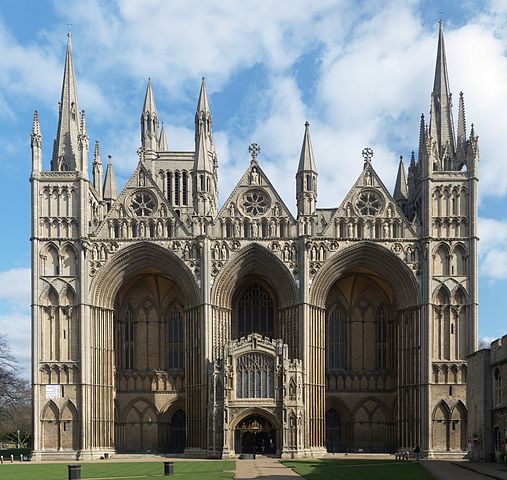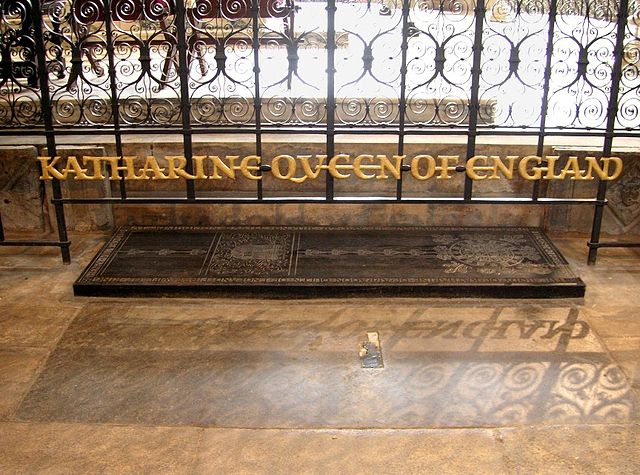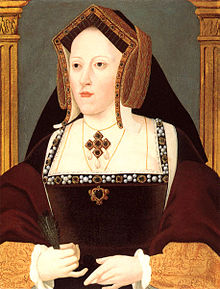After many years of the long, convoluted and tragic English civil strife called The Wars of the Roses, the House of Lancaster had finally prevailed. Henry Tudor, the Welsh prince with Lancaster blood in his veins through his mother Margaret Beaufort, had defeated Richard III of York at the Battle of Bosworth Field in 1485. On January 18, 1486, Henry VII married Elizabeth of York, niece of Richard III and daughter of King Edward IV. Thus, the Houses of Lancaster and York were united and Henry began to bring stability and peace to England.
Henry and Elizabeth’s first son Arthur was born September 20, 1486 and their second son Henry was born June 28, 1491. Henry VII’s claim to the English throne was dubious at best and some would call him a usurper. In trying to secure his position and increase the strength of the country, he looked for brides in foreign markets to marry his children. His choice of a wife for his eldest son Arthur was Catherine of Aragon.
Catherine of Aragon was born on December 16, 1485 near Madrid. She was the youngest child of King Ferdinand II of Aragon and Queen Isabella I of Castile. She was given a strong education in the classics, literature, canon and civil law and could speak Spanish, Latin, French and Greek. She also was brought up strictly in the Catholic faith which would play a large part in her life and fate. At the age of 3, she was betrothed to Arthur, Prince of Wales. In 1489, English ambassadors visited the court of her mother to finalize the terms.
Catherine came to England in November 1501 and met her groom for the first time. They were married 10 days later and immediately sent to live in Ludlow in the Welsh Marches, on the border of Wales. In April of 1502, they both became ill, possibly of the sweating sickness. Arthur died and Catherine survived as a widow. Henry VII did not want to return Catherine’s dowry to her father so it was agreed Catherine would marry Arthur’s brother, Prince Henry when he was old enough.
Catherine spent the next seven years, virtually a prisoner and in complete penury. Henry VII gave her little to live on and her pitiful pleas to her father for money survive in her letters. She was forced to sell the plate and jewels she had brought with her when she married Arthur. Henry VII finally died in the summer of 1509 and Catherine was free to marry the golden prince Harry.
Catherine and Henry VIII were married June 11, 1509. They were crowned together at Westminster Abbey on June 24. Catherine was 23 and Henry was just 18. The marriage was very successful in the beginning. Catherine and Henry were intellectual equals and enjoyed many pastimes together. They read, played music, danced, and had many deep discussions. Catherine immediately became pregnant and had a stillborn child in January 1510. A son was born on New Years Day of 1511 but only lived 52 days. Catherine would become pregnant many times but only one child survived childhood, the Princess Mary, born February 18, 1516.
Catherine continued to deepen and broaden her education as well as that of her daughter. Educating women became fashionable during this time because of her. Catherine also served as Regent of England when Henry went to war in France in 1513. While Henry was away, his army in England defeated the Scots at the Battle of Flodden Field. It was a great victory under Catherine’s watch.
By 1525, the captivating Anne Boleyn, one of Catherine’s ladies-in-waiting, had thoroughly bewitched Henry. He was beginning to believe his marriage to Catherine was cursed due to the lack of a male heir, because Catherine had been married to his brother. From 1526 to 1533, Anne spurned all of Henry’s romantic advances. She didn’t want to become the King’s mistress, like her sister Mary Boleyn had been. And her family, the powerful Howards, wanted her to become Queen to advance their interests. It was during these years Henry asked Catherine for an annulment of their marriage which she staunchly refused to do. In her eyes, her marriage to Arthur had never been consummated and due to her Catholic faith, she was truly Henry’s wife. Also, an annulment would bring into question the legitimacy of her daughter Mary and limit or end her chances of inheriting the throne.
All this led to a stalemate. Once Anne relented and gave in to Henry, she became pregnant and forced his hand. Since the Pope wouldn’t grant Henry an annulment of his marriage to Catherine, he decided to divorce himself from the Catholic Church. He made himself Head of the Church of England allowing the Archbishop of Canterbury to declare Henry’s marriage to Catherine null and void. Henry then married Anne Boleyn.
From this point on, Catherine was basically under house arrest. She was moved from castle to castle and not allowed to see her daughter. Her servants were reduced to the minimum and she had little money for food or clothing and finally succumbed to illness on January 7, 1536. It is said when they did an autopsy, her heart had a black mass in it. It wouldn’t be a stretch to say this proud Spanish princess died of a broken heart. She was buried in Peterborough Cathedral in Peterborough, Cambridgeshire.


Further reading: “ Catherine of Aragon” by Garrett Mattingly, “The Six Wives of Henry VIII” by Allison Weir, “Divorced Beheaded Survived: A Feminist Reinterpretation of the Wives of Henry VIII” by Karen Lindsey

[…] returned to the queen’s household. She carried the train of Catherine of Aragon during her wedding to Prince Arthur. She also witnessed the jousting tournaments staged for the […]
LikeLike
[…] nave as a kind of marketplace and meeting area and called it “Paul’s walk”. The wedding of Catherine of Aragon and Arthur Tudor, Prince of Wales and son of King Henry VII was held there in 1501. The building […]
LikeLike
[…] during the reigns of Kings Henry VIII and Edward VI. In an effort to dissolve his marriage to Katherine of Aragon and marry Anne Boleyn, Henry VIII broke with the Catholic Church, denied the pope was the head of […]
LikeLike
[…] seven years of a cat and mouse game where Anne teased Henry and held him off. Henry asked his wife, Catherine of Aragon for a divorce and she steadfastly refused. Henry then asked the Pope for a divorce or annulment due […]
LikeLike
[…] early as 1518, Henry had plans drawn up for a tomb for himself and his first wife Katherine of Aragon. The initial plans were made by the Italian sculptor Pietro Torrigiano, the same man who designed […]
LikeLike
[…] ideas were well established before King Henry VIII sought a divorce from Catherine of Aragon and initially, Henry himself showed little concern with evangelical political ideas. Upon the […]
LikeLike
[…] Henry to appoint his own man, Thomas Cranmer, to the position with the aim of ridding himself of Queen Katherine. Cromwell worked to pass legislation to clear the way for Cranmer to declare, once and for all, the […]
LikeLike
[…] Regent before his invasion fleet left Dover for France. The first grant, by Letters Patent, stated: “Katherine, Queen Consort. To be Regent and Governess of England, Wales and Ireland, during the King’s absence in his […]
LikeLike
[…] revenue, including Queen’s Gold. Historical evidence shows the naming of receiver generals for Catherine of Aragon, Anne Boleyn and Katherine Parr to collect Queen’s Gold. Then, the practice goes into abeyance […]
LikeLike
[…] Windsor Castle by Henry, Prince of Wales, who was supposedly still affianced to Juana’s sister, Catherine of Aragon. Henry was accompanied by five earls and diverse lords and knights, as well as others to the number […]
LikeLike
[…] While I can highly recommend all three of these biographies, Tremlett’s volume is not quite as academic in tone as Peggy Liss’ book and is somewhat more detailed than Downey’s. All three will give the reader a well-rounded view of Isabella of Castile, Europe’s first great Queen. I’m looking forward to reading Tremlett’s book about Isabella’s daughter, Catherine of Aragon. […]
LikeLike
[…] was chosen to serve as a maid of honor to Queen Katherine of Aragon. Her future husband, Edward Seymour was knighted in 1523 and became an esquire of the body to King […]
LikeLike
[…] April 1509, Henry VII died. Henry quickly married Katherine of Aragon, and they were both anointed and crowned two weeks later. Just short of his eighteenth birthday, […]
LikeLike
[…] There is no evidence the marriage between William and Mary Boleyn was hastily arranged to cover for her affair with Henry VIII and nothing to indicate it was a love match. No details of the dowry survive but it was considered a good marriage. There is reason to believe, because Willian was a rising star at court, the marriage politically and socially bolstered the Boleyn family’s ambitions at the time. Henry was courting Mary’s sister Anne, despite his long-standing marriage to Catherine of Aragon. […]
LikeLike
[…] of Henry VII’s greatest political coups was brokering a marriage for Arthur with Catherine of Aragon, the youngest daughter of the Catholic Majesties, Ferdinand and Isabella. This union between […]
LikeLike
[…] from the time of her father’s decision to extricate himself from his marriage to her mother Catherine of Aragon, which made her ability to deal with her illnesses even more […]
LikeLike
[…] days after her birth, Frances was christened in the church of St. Etheldreda. Her godmothers were Catherine of Aragon and Princess […]
LikeLike
[…] The Freelance History Writer […]
LikeLike
[…] having lived together for five months. Diplomatically his death was a catastrophe for Henry, as Catherine was the daughter of Europe’s most powerful King, Ferdinand of Spain. A carriage draped all in […]
LikeLike
[…] prepare her son Louis, Duke of Guyenne for his future role as king. Moving into the Tudor reign, Katherine of Aragon acted as regent for Henry VIII when he went to war in France in 1513 and was actually victorious in […]
LikeLike
[…] part you can visit graves of royalty in public churches, abbeys and cathedrals with no fees such as Catherine of Aragon’s in Peterborough Cathedral, Arthur Tudor’s grave in Worcester Cathedral, Mary Tudor, Queen of […]
LikeLike
[…] for a teenage woman. Elizabeth and Margaret also both wrote to the Spanish court asking that Catherine of Aragon learn French so they could communicate with her upon her arrival to marry Prince […]
LikeLike
[…] being literate. In 1509, Elizabeth was appointed a lady-in-waiting to King Henry VIII’s new Queen, Catherine of Aragon and came to court to live. She would serve Catherine for sixteen years, becoming her lifelong […]
LikeLike
[…] in 1501, Margaret was a member of Katherine of Aragon’s household and served her during her marriage to Prince Arthur. Once Arthur died, her service to […]
LikeLike
[…] motion a plan to elevate Lady Jane Grey to the throne. Mary Tudor, daughter of King Henry VIII and Catherine of Aragon had something to say about this plan. After declaring herself queen and raising an army, Mary […]
LikeLike
[…] VII’s foreign policy was the pursuit of a marriage between his son Arthur, Prince of Wales and Catherine, Infanta of Spain. As early as the spring of 1489, English ambassadors were sent to hold important talks with […]
LikeLike
I am also a great enthusiast of the Tudor era. Katherine of Aragon is one of my favorite women of the time. I admire how strong she was and her depth of faith. Thank you for this article
LikeLiked by 1 person
[…] at Greenwich on February 18, 1516, the only surviving child of King Henry VIII of England and Catherine of Aragon. Her baptism was celebrated two days later in the church of the Observant Friars next to the […]
LikeLike
[…] There is some discrepancy regarding the year Norfolk married Agnes. Some records indicate they were married shortly after Elizabeth Howard died but there is an argument to be made that they were married in 1509. Judging by the dates when Agnes’ children were born, the later date seems likely. Agnes and Thomas had seven children together of which two sons and four daughters survived. In 1516, Agnes acted as godmother for the Princess Mary, daughter of Henry VIII and Katherine of Aragon. […]
LikeLike
[…] Tudor, Prince of Wales and son of King Henry VII of England, may have died of the disease, leaving Catherine of Aragon a widow. The best friend of King Henry VIII, Charles Brandon, Duke of Suffolk had two young sons, […]
LikeLike
[…] Henry VIII was dead set on repudiating his wife Catherine of Aragon. It was obvious she had reached the age when she could no longer have children and Henry was in […]
LikeLike
[…] was made with Queen Isabel of Castile and Ferdinand of Aragon. Arthur was to marry their youngest daughter Catherine, the sister of Juan, Prince of […]
LikeLike
[…] some time, Mary, eldest daughter of King Henry VIII, had been separated from her mother Katherine of Aragon and was forbidden to have any contact with her on the orders of her father. Henry married Anne […]
LikeLike
[…] wedding was a grand affair. The preparations for the wedding were based on those of Mary’s mother Catherine of Aragon to Prince Arthur […]
LikeLike
[…] was in favor with King Henry VIII early on but during the divorce crisis, his mother supported Katherine of Aragon. He was also associated with the alienated families of the Poles and the Nevilles. Edward’s […]
LikeLike
[…] after this household was established, the Princess Mary, daughter of Henry VIII and Catherine of Aragon, joined the establishment. Mary had been declared illegitimate and was no longer allowed use the […]
LikeLike
[…] next king. One of Henry VII’s greatest political coups was brokering a marriage for Arthur with Catherine of Aragon, the youngest daughter of the Catholic Majesties, Ferdinand and Isabella. This union between […]
LikeLike
[…] suffering for many years as King Henry VIII tried to extricate himself from his marriage, Catherine of Aragon died at Kimbolton Castle on January 7, 1536 at the age of fifty. King Henry himself chose […]
LikeLike
[…] treatment of Mary. Butts countered the rumors at court that Mary was incurably ill and eventually Katherine of Aragon’s physician treated […]
LikeLike
[…] from the time of her father’s decision to extricate himself from his marriage to her mother Catherine of Aragon which made her ability to deal with her illnesses even more […]
LikeLike
[…] together. The eldest, Arthur, born in 1486, would be given the title of Prince of Wales and married Catherine of Aragon, daughter of the Spanish monarchs Ferdinand and Isabella. The marriage would be one of Henry’s […]
LikeLike
I know spellings were not as important in Tudor times, but why if her burial place is spelt with a K has no-one adopted this final spelling of her name?
LikeLike
The spellings are interchangable. Her name was Caterina in Spanish so that is where the “C” spelling comes from. In English the name is spelled with a “K” so this is probably why it is spelled that way on the grave.
LikeLiked by 1 person
A very honest and faithful recording of history. Well done, Susan.
LikeLike
Reblogged this on History's Untold Treasures and commented:
H/T The Freelance History Writer
LikeLike
Excellent — concise and interesting! Thanks very much.
LikeLike
Thank you Mary!
LikeLike
So glad you liked my blog on Catherine of Aragon. Keep reading for more on Henry’s wives.
LikeLike
Concise and informative. I love the Tudor era!
LikeLike
I love the Tudor’s too Diane! Keep reading. I’ll post Anne Boleyn in the next couple of days.
LikeLike